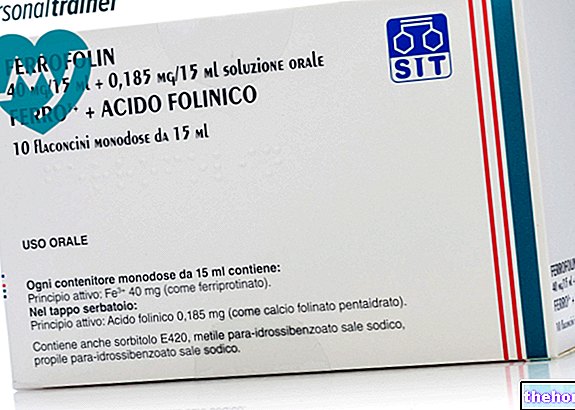Active ingredients: Flunisolide
LUNIBRON 30 mg / 30 ml solution to be nebulised
Lunibron package inserts are available for pack sizes:- LUNIBRON 30 mg / 30 ml solution to be nebulised
- LUNIBRON 2 mg / 2 ml solution for nebulisation, LUNIBRON 1 mg / 2 ml solution for nebulisation
Indications Why is Lunibron used? What is it for?
PHARMACOTHERAPEUTIC CATEGORY
Anti-inflammatory, anti-asthmatic glycocorticoid.
THERAPEUTIC INDICATIONS
Control of the evolution of asthmatic disease and conditions of bronchostenosis, chronic asthmatic bronchitis.
Chronic and seasonal allergic rhinitis, including hay fever
Contraindications When Lunibron should not be used
Hypersensitivity to the active substance or to any of the excipients.
Active or quiescent pulmonary tuberculosis. Bacterial, viral or fungal infections.
Generally contraindicated in pregnancy and lactation (see Special warnings)
Precautions for use What you need to know before taking Lunibron
Flunisolide, like all corticosteroids, should be used with caution, if not avoided, in patients with active, or dormant, tuberculous infections of the respiratory tract or with untreated fungal, bacterial or viral infections, or with herpes simplex diseases. eyes.
Due to the inhibitory effect of corticosteroids on scarring, it is advisable to use flunisolide with caution in patients with previous or recent nasal trauma, with nasal septal ulcer or with recurrent epistaxis.
Although dysmicrobisms have rarely been reported, it is advisable to control, especially for prolonged treatments, the possible variation of the microbial flora of the upper airways by instituting, if necessary, a cover therapy
The effect of Lunibron, as with all inhaled corticosteroids, is not immediate.
It should therefore be borne in mind that Lunibron is not effective in ongoing asthma crises and that it is advisable to stick to regular use of the product for several days.
It is not recommended to administer to children under four years of age.
In case of prolonged topical use and at high doses, it is good to keep in mind the possibility of inhibition of adrenal activity and mucosal atrophy, although it has not been demonstrated in clinical experience an absorption of the product sufficient to produce general effects.
Rarely, a range of psychological and behavioral effects may occur, including psychomotor hyperactivity, sleep disturbances, anxiety, depression, aggression, behavioral disturbances (predominantly in children).
It is important to take the dose as directed in the package leaflet or as prescribed by your doctor. You should not increase or decrease the dose without first consulting your doctor.
Interactions Which drugs or foods can modify the effect of Lunibron
Not known
Warnings It is important to know that:
The use of the product, especially if prolonged, can give rise to sensitization phenomena and exceptionally to the classic systemic side effects of the drug.
In this case, treatment must be interrupted and appropriate therapy instituted.
Whenever corticosteroids are used, it should be borne in mind that they can mask some symptoms of infection and that new infectious processes can be established during their use.
The recommended doses should not be exceeded. This increase, in fact, in addition to not improving the therapeutic efficacy of the product, involves the risk of systemic effects from absorption.Transfer from systemic steroid therapy to flunisolide therapy should be done with caution if there is reason to suspect the presence of adrenal functional changes: abrupt discontinuation of systemic treatment is generally to be avoided.
The conduct of treatment in patients already under systemic corticotherapy requires special precautions and close medical surveillance, since the reactivation of adrenal function, suppressed by prolonged systemic corticoid therapy, is slow.
In any case, it is necessary that the disease is relatively "stabilized" with systemic treatment.
Initially Lunibron should be administered while continuing the systemic treatment, subsequently this should be progressively reduced by checking the patient at regular intervals and modifying the Lunibron dosage according to the results obtained. During times of stress or severe asthmatic attack, patients undergoing this transition will need to have additional systemic steroid treatment. In these patients, periodic checks of cortico-adrenal function should also be performed, including early morning measurements of cortisol levels in conditions of rest.
In steroid-dependent patients, a gradual and controlled transition from oral to topical endobronchial therapy is recommended.
For those who carry out sporting activities: the use of the drug without therapeutic necessity constitutes doping and can in any case determine positive anti-doping tests.
Use during pregnancy and lactation
The product is not recommended in the first three months of pregnancy; in the further period and during lactation, the product should be administered only in cases of real need and under the direct supervision of the doctor.
Dose, Method and Time of Administration How to use Lunibron: Posology
Lunibron must be used with electric nebulizers including ultrasound and can be diluted with physiological solution.
Unless otherwise prescribed by the doctor, the following dosage is recommended:
Adults: 1 mg (25 drops) twice a day.
Children: 20 µg / kg twice a day.
1 drop of Lunibron corresponds to 40 microliters and 40 micrograms of Flunisolide.
To determine the dose, expressed in drops, as a function of body weight, refer to the following table
Correlation of weight, number of drops and mg of Flunisolide
Instructions for Use
To prevent the bottle from being easily opened, a dropper was used to open which requires a movement that is not instinctive but rational.
To open the bottle it is necessary to exert a pressure on the dropper ring nut and a counterclockwise twist at the same time.
To close the bottle, the ring nut must be screwed clockwise as usual. As is known, the administration of drugs in solution by means of electric nebulizers involves a residue of solution which, adhering to the walls of the vial or to the bottom, is not dispensed.
Taking this into account, it is necessary, during the preparation phase, to consider the need to integrate the non-payable part.
Lunibron can be used in the course of bronchodilator, chemotherapy and cortisone therapy in the replacement phase of oral corticotherapy.
Overdose What to do if you have taken too much Lunibron
Administration of high doses of flunisolide over a short period of time may result in suppression of hypothalamic-pituitary-adrenal function. In this case, the administered dose should be reduced immediately to the recommended dose.
Side Effects What are the side effects of Lunibron
Only a few patients, with very sensitive airways, experienced cough and hoarseness. Fungal infections in the mouth or throat have rarely been observed and disappeared rapidly after appropriate local therapy. These infections can be prevented or minimized if patients rinse their mouth thoroughly after each administration.
Following the rhinological use of the product, slight transient burning may occur as well as a tingling that could be so intense as to force the suspension of the treatment. Other side effects observed following the rhinological use of Flunisolide are in descending order: nasal irritation, epistaxis, stuffy nose, runny nose, sore throat, hoarseness and throat irritation. If severe, these side effects may require discontinuation of therapy.
Only in case of incongruous use can the typical effects of systemically administered corticosteroids occur, albeit to a lesser extent.
The most common undesirable effect encountered in cortico-dependent patients was the onset of nasal congestion and nasal polyps, due precisely to the reduction of systemic corticotherapy. Patients should however be closely monitored in the case of prolonged treatments, in order to ascertain promptly the possible appearance of systemic manifestations (osteoporosis, peptic ulcer, signs of secondary adrenocortical insufficiency, such as hypotension and weight loss) in order to avoid in the latter case very serious accidents from acute hypoadrenalism.
Side effects that may arise, with unknown frequency, are psychomotor hyperactivity, sleep disturbances, anxiety, depression, aggression, behavioral disturbances (mainly in children).
Compliance with the instructions contained in the package leaflet reduces the risk of undesirable effects.
It is important to communicate to the doctor or pharmacist any undesirable effect, even if different from those indicated above.
Expiry and Retention
See the expiry date indicated on the package.This date is intended for the product in intact packaging, correctly stored.
Storage: Store in the original packaging to protect the product from light.
The opened package must be used within 30 days. Excess product must be thrown away.
Warning: do not use the product beyond the expiration date indicated on the package.
KEEP OUT OF THE SIGHT AND REACH OF CHILDREN
COMPOSITION
A 30ml multidose container contains
Active principle:
Flunisolide 30 mg
One drop contains 40 micrograms of Flunisolide.
Excipients: Sodium chloride, Propylene glycol, Purified water, Hydrochloric acid sol 1N.
PHARMACEUTICAL FORM AND CONTENT
Solution to be sprayed. Pack of a 30 ml multidose container
Source Package Leaflet: AIFA (Italian Medicines Agency). Content published in January 2016. The information present may not be up-to-date.
To have access to the most up-to-date version, it is advisable to access the AIFA (Italian Medicines Agency) website. Disclaimer and useful information.
01.0 NAME OF THE MEDICINAL PRODUCT
LUNIBRON
02.0 QUALITATIVE AND QUANTITATIVE COMPOSITION
Lunibron 30 mg / 30 ml Solution to be nebulised
100 ml contain:
Active ingredient: Flunisolide 100 mg
One drop contains 40 mcg of Flunisolide
Lunibron 2 mg / 2 ml Solution to be nebulised
A single-dose container contains:
Active ingredient: Flunisolide 2 mg
Lunibron 1 mg / 2 ml Solution to be nebulised
A single-dose container contains:
Active ingredient: Flunisolide 1 mg
For excipients see par. 6.1
03.0 PHARMACEUTICAL FORM
Solution to be sprayed.
04.0 CLINICAL INFORMATION
04.1 Therapeutic indications
Control of the evolution of asthmatic disease and conditions of bronchostenosis, chronic asthmatic bronchitis. Chronic and seasonal allergic rhinitis, including hay fever.
04.2 Posology and method of administration
Lunibron 30 mg / 30 ml nebuliser solution (multidose container)
It must be used with electric nebulizers including ultrasound and can be diluted with physiological solution.
Unless otherwise prescribed by the doctor, the following dosage is recommended:
Adults: 1 mg (25 drops) 2 times a day.
CHILDREN: 20 mcg / kg 2 times a day.
1 drop of Lunibron corresponds to 40 microliters and 40 mcg of Flunisolide.
To determine the dose, expressed in drops, as a function of body weight, refer to the following table:
Correlation of weight, number of drops and mg of Flunisolide
Lunibron 2 mg / 2 ml and Lunibron 1 mg / 2 ml nebuliser solution (single-dose container)
It must be used with electric nebulizers for both outpatient and home use. The solution must be used as it is without diluting
ADULTS: Single-dose containers of 2 mg / 2ml: 1 ml (corresponding to half the container), equal to 1 mg, twice a day.
CHILDREN: Single-dose containers of 1 mg / 2ml: 1 ml, corresponding to half a dose equal to 500 mcg, twice a day.
For correct use of the multi-dose container and single-dose containers, see. par. 6.6.
As is known, the administration of drugs in solution by means of electric nebulizers involves a residue of solution which, adhering to the walls of the phial or to the bottom, is not dispensed.
Taking this into account, it is necessary, during the preparation phase, to consider the need to integrate the non-payable part.
Lunibron can be used in the course of therapy with bronchodilators, chemotherapy and in the replacement phase of oral corticotherapy.
04.3 Contraindications
Hypersensitivity to the active substance or to any of the excipients.
Active or quiescent pulmonary tuberculosis. Bacterial, viral or fungal infections.
Generally contraindicated in pregnancy and lactation (see section 4.6)
04.4 Special warnings and appropriate precautions for use
The use of the product, especially if prolonged, can give rise to sensitization phenomena and exceptionally to the classic systemic side effects of the drug.
In this case, treatment must be interrupted and appropriate therapy instituted.
Whenever corticosteroids are used, it should be borne in mind that they can mask some symptoms of infection and that new infectious processes can be established during their use.
The recommended doses should not be exceeded. This increase, in fact, in addition to not improving the therapeutic efficacy of the product, involves the risk of systemic effects from absorption.
Transfer from systemic steroid therapy to flunisolide therapy should be done with caution if there is reason to suspect the presence of adrenal functional changes; abrupt discontinuation of systemic treatment is generally to be avoided.
In steroid-dependent patients, a gradual and controlled transition from oral to topical endobronchial therapy is recommended.
The conduct of treatment in patients already under systemic corticotherapy requires special precautions and close medical surveillance, since the reactivation of adrenal function, suppressed by prolonged systemic corticoid therapy, is slow.
In any case, it is necessary that the disease is relatively "stabilized" with systemic treatment.
Initially Lunibron should be administered while continuing the systemic treatment, subsequently this should be progressively reduced by checking the patient at regular intervals and modifying the dosage of Lunibron depending on the results obtained.
During times of stress or severe asthmatic attack, patients undergoing this transition will need to have additional systemic steroid treatment. In these patients, periodic checks of cortico-adrenal function should also be performed, including early morning measurements of cortisol levels in conditions of rest.
In case of prolonged topical use and at high doses, it is good to keep in mind the possibility of inhibition of adrenal activity and mucosal atrophy, although it has not been demonstrated in clinical experience an absorption of the product sufficient to produce general effects.
Systemic effects may occur with inhaled corticosteroids, particularly when prescribed in high doses for prolonged periods. These effects are less likely to occur than with oral corticosteroid treatment. Possible systemic effects include Cushing's syndrome, Cushingoid aspect, adrenal suppression, growth retardation in children and adolescents, decreased bone mineral density, cataracts, glaucomae, more rarely a range of psychological or behavioral effects including psychomotor hyperactivity, sleep, anxiety, depression or aggression (particularly in children). & EGRAVE; It is therefore important that the dose of the inhaled corticosteroid is the lowest possible dose with which effective control of asthma is maintained.
Flunisolide, like all corticosteroids, should be used with caution, if not avoided, in patients with active or dormant tuberculous infections of the respiratory tract or with untreated fungal, bacterial or viral infections, or with herpes simplex eyes.
Due to the inhibitory effect of corticosteroids on scarring processes, it is advisable to use Flunisolide with caution in patients with previous or recent nasal trauma, with nasal septal ulcer or with recurrent epistaxis.
Although dysmicrobisms have rarely been reported, it is advisable to check, especially for prolonged treatments, the possible variation of the microbial flora of the upper airways by instituting, if necessary, a cover therapy.
The effect of Lunibron, as with all inhaled corticosteroids, it is not immediate.
It should therefore be borne in mind that Lunibron it is not effective in ongoing asthma crises and it is advisable to stick to regular use of the product for several days.
It is not recommended to give to children under four years of age.
04.5 Interactions with other medicinal products and other forms of interaction
Not known.
04.6 Pregnancy and lactation
The product is not recommended in the first three months of pregnancy; in the further period and during lactation, the product should be administered only in cases of real need and under the direct supervision of the doctor.
04.7 Effects on ability to drive and use machines
You don't notice.
04.8 Undesirable effects
Only a few patients, with very sensitive airways, presented cough and hoarseness; sometimes there may be a slight and transient burning of the nasal mucosa, as well as a tingling that could be so intense as to force the suspension of the treatment. Fungal infections in the mouth or throat have rarely been observed and disappeared rapidly after appropriate local therapy.
These infections can be prevented or minimized if patients rinse their mouth thoroughly after each administration.
Other side effects observed are: nasal irritation, epistaxis, stuffy nose, runny nose, sore throat, hoarseness and throat irritation. If severe, these side effects may require discontinuation of therapy.
Only in case of incongruous use can the typical effects of systemically administered corticosteroids occur, albeit to a lesser extent.
The most common undesirable effect found in cortico-dependent patients was the onset of nasal congestion and nasal polyps, due precisely to the reduction of systemic corticotherapy. Patients should however be closely monitored in the case of prolonged treatments, in order to promptly ascertain the possible appearance of systemic manifestations (osteoporosis, peptic ulcer, signs of secondary cortico-adrenal insufficiency, such as hypotension and weight loss) in order to avoid in this latter eventuality very serious accidents from acute hypoadrenalism.
04.9 Overdose
Administration of high doses of flunisolide over a short period of time may result in suppression of hypothalamic-pituitary-adrenal function. In this case, the administered dose should be reduced immediately to the recommended dose.
05.0 PHARMACOLOGICAL PROPERTIES
05.1 Pharmacodynamic properties
R03BA03 - Other drugs for obstructive respiratory tract syndromes by aerosol - glucocorticoids
Flunisolide, active ingredient of Lunibron, is a synthetic fluorinated corticosteroid, characterized from a pharmacodynamic point of view by a high anti-inflammatory activity for topical application.
Administered to the animal by inhalation at therapeutic doses, it does not present systemic effects either of a corticomimetic type, in a glucocorticoid or mineralocorticoid sense, or of an inhibitory type on the pituitary-adrenal axis.
Clinical experience with Lunibron confirmed the anti-reaction, anti-edema and anti-inflammatory properties of Flunisolide.
05.2 "Pharmacokinetic properties
Flunisolide is rapidly absorbed and metabolised and its major metabolite is pharmacologically nearly inactive.
The topical application of Lunibron by inhalation directly into the airways it allows to implement a targeted and efficient therapy, generally not burdened by the side effects that often accompany the non-topical administration of steroid preparations.
05.3 Preclinical safety data
In acute toxicity tests, for intramuscular administration and buccal inhalation of Flunisolide in various animal species, at doses between 500 and 5000 mcg / animal, and for intramuscular administration at doses of 520 and 1040 mg / kg in rats and mice, no no toxic symptoms were observed.
Similarly, no abnormal findings were observed in the subacute toxicity tests, lasting 40 days, in which doses of 1250-2500 mcg / animal per day were administered to the rabbit by mouth inhalation and in the chronic toxicity tests of the duration of 120 days, in which daily doses of Flunisolide of 150, 300 and 350 mcg / animal were administered to the rabbit via intranasal and to the dog, by endobronchial inhalation, doses of 1250, 2000 and 2500 mcg / animal. Treatment with Flunisolide was also well tolerated locally.
06.0 PHARMACEUTICAL INFORMATION
06.1 Excipients
Multidose container: Sodium chloride, Propylene glycol, Purified water, Sol 1N hydrochloric acid
Single-dose containers: Propylene glycol, Sodium chloride, Citric acid, Sodium citrate, Water for injections.
06.2 Incompatibility
Not known.
06.3 Period of validity
Multidose container: 3 years The opened package must be used within 30 days. Excess product must be thrown away.
Single-dose containers: 2 years. The solution must be used within 24 hours after opening the container (store at a temperature between 2 ° C and 8 ° C - in the refrigerator). The excess product must be thrown away.
06.4 Special precautions for storage
Keep the containers in the original packaging to protect the product from light.
06.5 Nature of the immediate packaging and contents of the package
Multidose container: polyethylene bottle with graduated dropper, with child resistant closure. Packaging: 30 mL multidose container
Single-dose containers: container in neutral, yellow, type I glass. Packaging: 15 single-dose containers of 2 ml.
06.6 Instructions for use and handling
Lunibron 30 mg / 30 ml Solution to be nebulised
To prevent the bottle from being easily opened, a dropper was used to open which requires a movement that is not instinctive but rational.
To open the bottle it is necessary to exert a pressure on the dropper ring nut and a counterclockwise twist at the same time. To close the bottle, the ring nut must be screwed clockwise as usual
Lunibron 2 mg / 2 ml Solution to be nebulised
Lunibron 1 mg / 2 ml Solution to be nebulised
A. Open the container by exerting light pressure on the torch.
B. Take the contents in the prescribed quantity with the help of a syringe or by turning the open container upside down and tapping on the bottom of it with a finger. To withdraw only 1 ml, empty up to the mark indicated on the container.
07.0 MARKETING AUTHORIZATION HOLDER
Valeas s.p.a. - Chemical and Pharmaceutical Industry - Via Vallisneri, 10 - 20133 Milan
08.0 MARKETING AUTHORIZATION NUMBER
Lunibron 30 mg / 30 ml solution to be nebulised: bottle 30 ml A.I.C. No. 026886059
* Lunibron 2 mg / 2 ml solution to be nebulized: 15 single-dose containers 2 ml A.I.C. No. 026886073
* Lunibron 1 mg / 2 ml solution to be nebulized: 15 single-dose containers 2 ml A.I.C. No. 026886085
* Not commercially
09.0 DATE OF FIRST AUTHORIZATION OR RENEWAL OF THE AUTHORIZATION
Lunibron 30 mg / 30 ml solution to be nebulised
Lunibron 2 mg / 2 ml Solution to be nebulised
Lunibron 1 mg / 2 ml Solution to be nebulised
AIC renewal: May 2010
10.0 DATE OF REVISION OF THE TEXT
January 2013




























